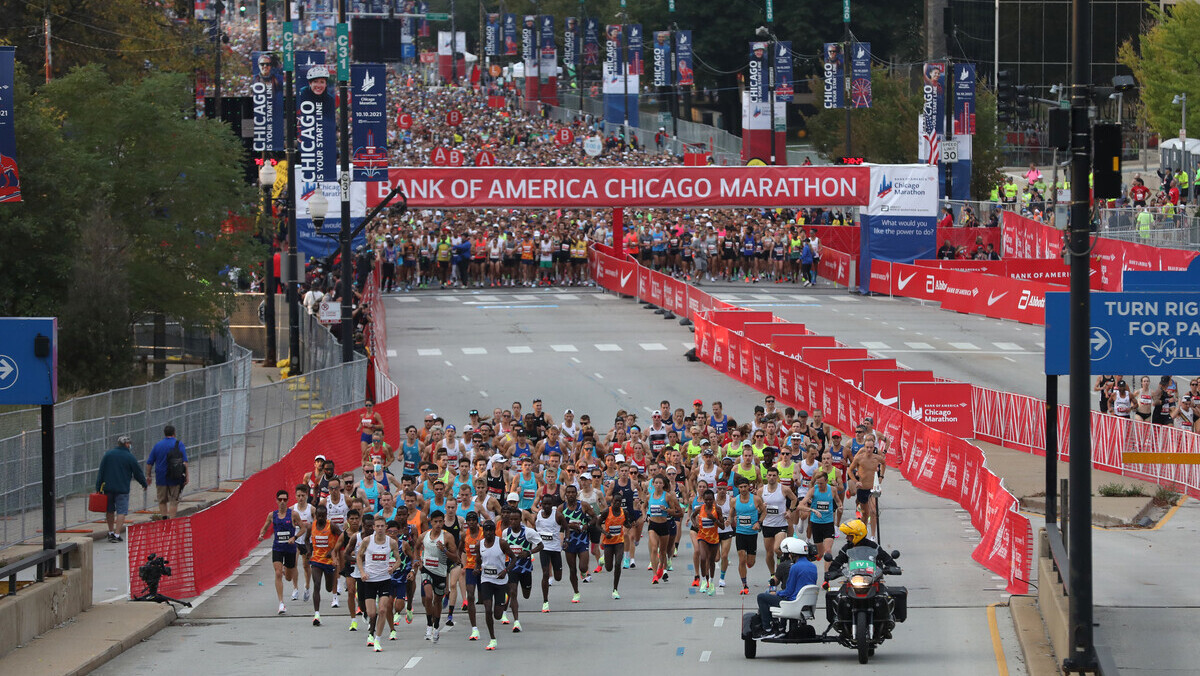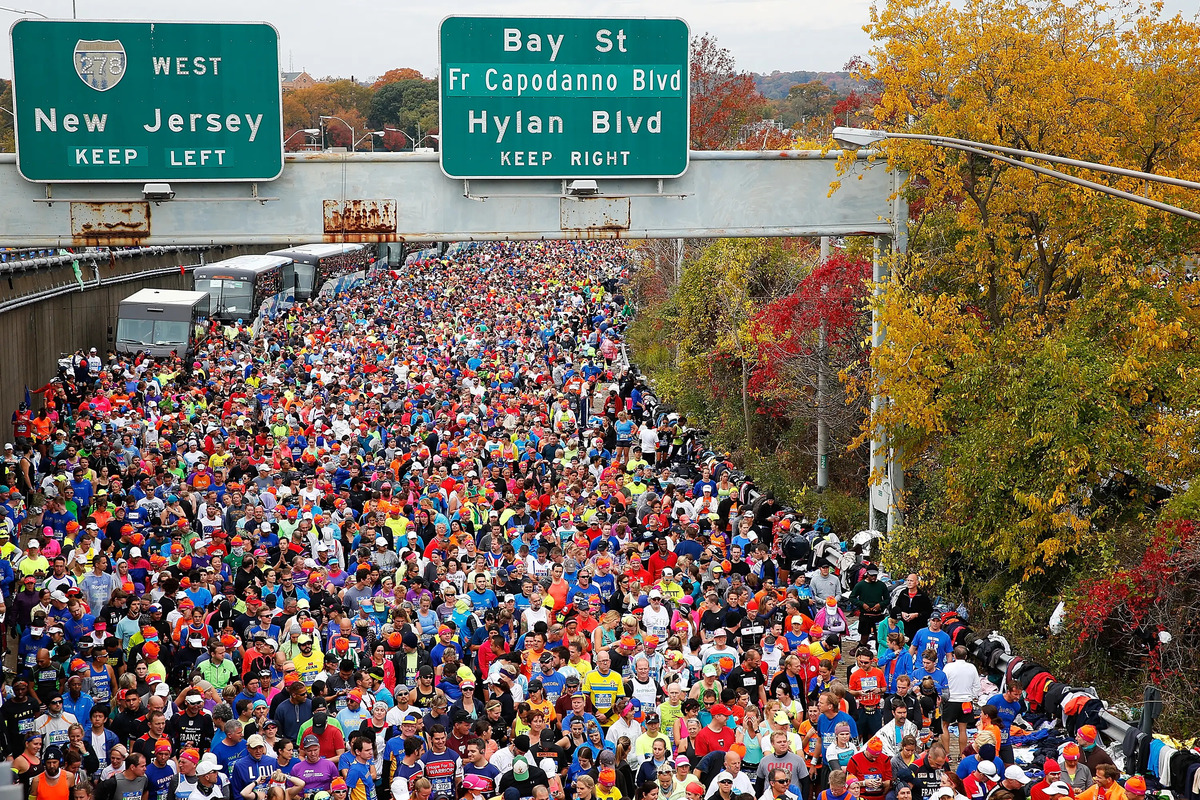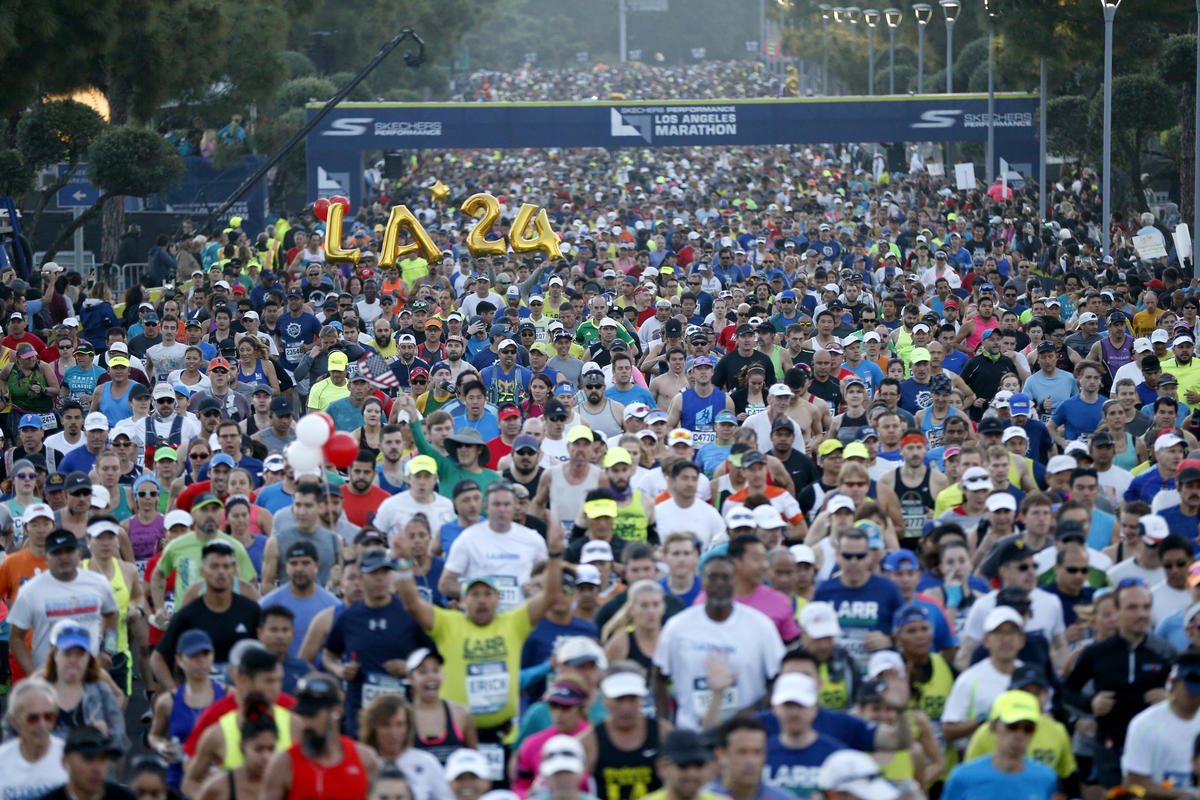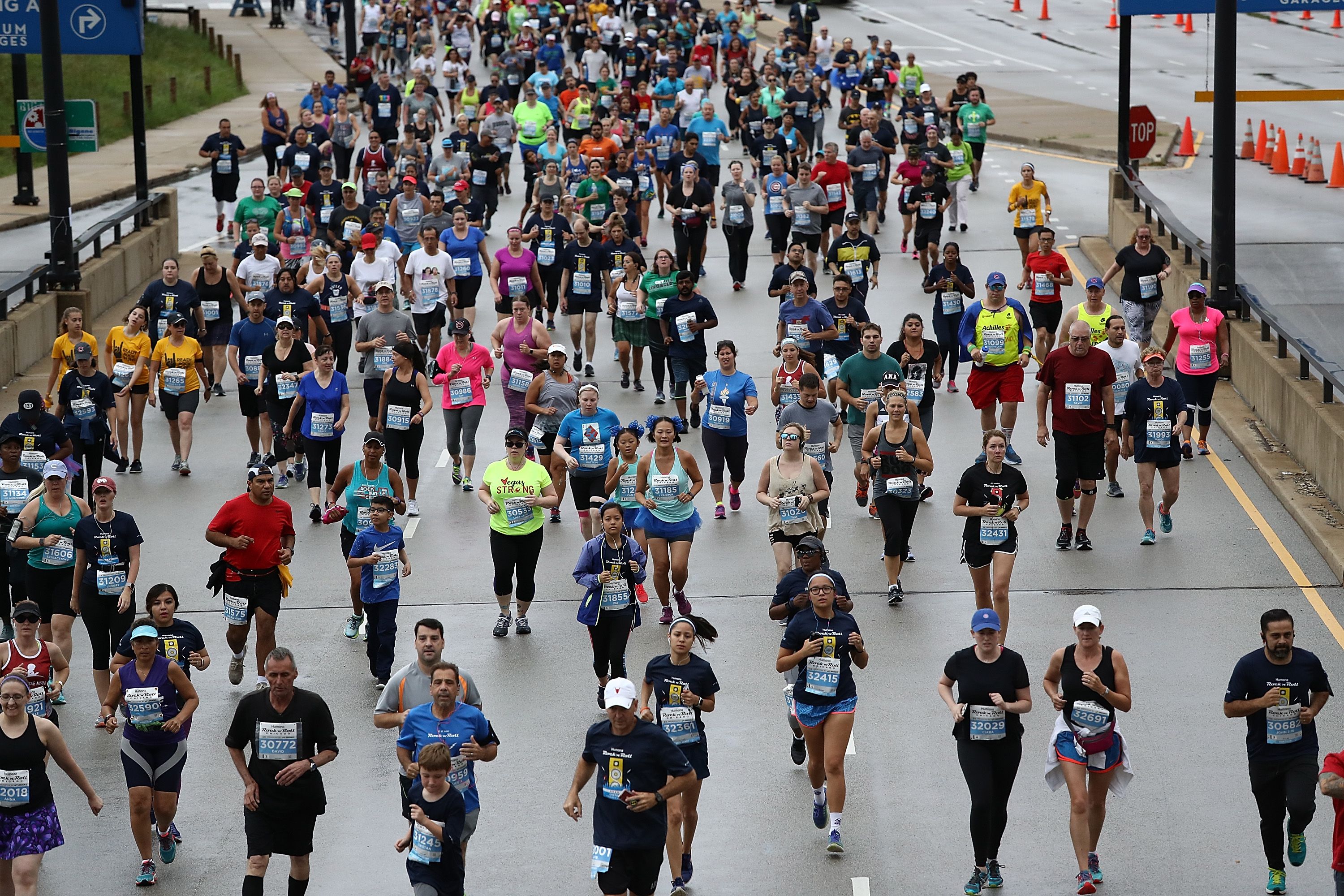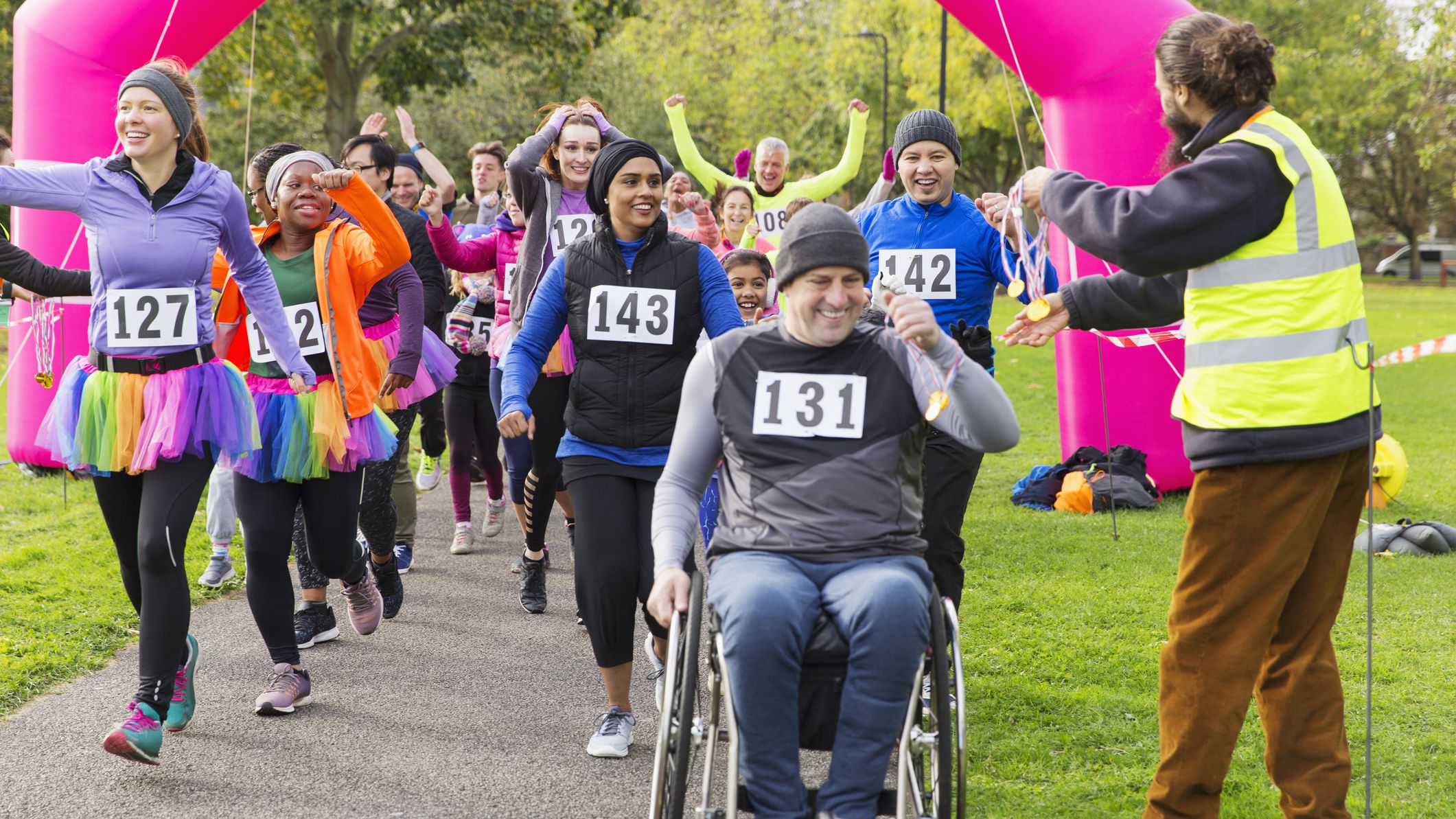

Featured
How To Fundraise For A Marathon
Published: August 28, 2023
Looking to fundraise for a marathon? Get featured and learn how to raise funds effectively with our expert tips and strategies.
Introduction
Welcome to the world of marathon fundraising! Running a marathon is a remarkable feat of physical endurance, but it can also be an incredible opportunity to make a positive impact and raise funds for a cause you care deeply about. Whether it’s for a charity, a nonprofit organization, or a personal cause, fundraising for a marathon allows you to combine your passion for running with a greater purpose.
Marathon fundraising not only helps generate much-needed funds for worthy causes, but it also allows you to spread awareness and engage with your community. It’s an opportunity to rally support and make a meaningful difference in the lives of others. While the idea of raising a significant amount of money may seem daunting at first, with the right plan and strategy, you can achieve your fundraising goals and exceed expectations.
In this article, we will guide you through the ins and outs of fundraising for a marathon. We’ll explore various methods and strategies to help you reach your fundraising goals, engage with your network, and maximize your impact. From setting a fundraising goal to leveraging online platforms, engaging with local communities, and expressing gratitude to your donors, we’ll cover all the essential steps to ensure your marathon fundraising campaign is a success.
So, whether you’re a seasoned marathon runner looking to take your fundraising efforts to the next level or a first-time fundraiser seeking guidance, let’s dive in and discover the key elements to make your marathon fundraising journey a memorable and rewarding one.
Setting a Fundraising Goal
Before diving into the world of marathon fundraising, it’s crucial to establish a clear and attainable fundraising goal. Setting a goal will not only provide you with a sense of direction but also motivate you throughout your fundraising journey. Here are some steps to help you set a meaningful fundraising goal:
- Evaluate the Cause: Firstly, consider the cause or organization you are supporting. Research their funding needs, understand their mission, and assess how much financial support they require to make a significant impact.
- Consider Personal Connection: Reflect on your personal connection to the cause. How passionate are you about it? How much do you believe in their mission? Consider these factors when determining the level of commitment you want to make in terms of fundraising.
- Assess Your Network: Take stock of your network of friends, family, colleagues, and acquaintances who may be willing to support your fundraising efforts. Consider their financial capabilities and estimate how much you can reasonably expect to raise through their contributions.
- Set a Realistic Target: Once you have considered the previous factors, set a fundraising goal that is both challenging and attainable. Aim for a specific monetary target that will have a meaningful impact on the cause, while also taking into account your network’s potential contribution.
Remember, setting a clear and realistic fundraising goal will help guide your efforts and inspire potential donors. It will also provide you with a benchmark to track your progress and adjust your strategy if needed.
Additionally, breaking down your fundraising goal into smaller milestones can be a great way to stay motivated and sustain momentum throughout your campaign. For example, you can set monthly or weekly sub-goals and celebrate each achievement along the way.
By setting a well-defined fundraising goal, you will not only provide a sense of purpose to your campaign but also inspire others to contribute to your cause. Now that you have set your goal, it’s time to create a fundraising plan to help you turn your aspirations into reality.
Creating a Fundraising Plan
To successfully fundraise for a marathon, it’s essential to have a well-thought-out plan in place. A fundraising plan will serve as your roadmap, outlining the strategies and actions you need to take to achieve your goals. Here are key steps to consider when creating your fundraising plan:
- Identify Fundraising Strategies: Begin by brainstorming and researching various fundraising strategies that align with your cause and audience. This can include online campaigns, events, sponsorships, and more. Choose the strategies that you believe will be most effective in reaching your target audience and generating donations.
- Set a Timeline: Establish a timeline for your fundraising campaign, breaking it down into key milestones and deadlines. This will help you stay organized, track your progress, and ensure that you are on track to meet your fundraising goals. Be sure to consider any specific event-related deadlines, such as registration dates or fundraising milestones set by the marathon organizers.
- Create a Budget: Develop a budget to determine how much money you will need for various fundraising activities, such as event expenses, promotional materials, and online platform fees. Having a clear understanding of your budget will help you make informed decisions and allocate resources effectively.
- Outline Communication Strategies: Determine how you will communicate with potential donors and supporters. This can include crafting personalized emails, social media updates, creating a dedicated website or blog, or even leveraging traditional media outlets. Tailor your messaging to effectively convey your cause and inspire others to donate.
- Train and Recruit Team Members: If you have a team or volunteers who will be assisting with your fundraising efforts, ensure they are trained and knowledgeable about your cause and fundraising techniques. Delegate responsibilities and define each person’s role to streamline your efforts and maximize efficiency.
- Engage with Key Stakeholders: Determine who your key stakeholders are, such as sponsors, local businesses, or influential individuals in your community, and develop a plan to engage with them. This can include sponsorship proposals, partnership opportunities, or requesting their support through donations or promoting your cause.
Remember, a fundraising plan is not set in stone and can be adjusted and refined as you progress. Stay flexible and be open to adapting your strategies based on the feedback and response you receive from your audience and donors.
By creating a comprehensive fundraising plan, you will have a clear roadmap that ensures your efforts are focused and organized. It will help you stay on track, engage with your audience effectively, and ultimately increase your chances of reaching and surpassing your fundraising goals.
Utilizing Online Fundraising Platforms
In today’s digital age, online fundraising platforms have become powerful tools for facilitating fundraising campaigns and reaching a wider audience. Utilizing these platforms can significantly boost your marathon fundraising efforts. Here are some key considerations when utilizing online fundraising platforms:
- Choose the Right Platform: Research and select an online fundraising platform that aligns with your needs and preferences. Consider factors such as transaction fees, platform features, user-friendliness, and the ability to customize your campaign page. Popular platforms include GoFundMe, JustGiving, and Crowdfunding sites like Kickstarter and Indiegogo.
- Create an Engaging Campaign Page: Design a visually appealing and compelling campaign page that clearly communicates your cause, your personal story, and your fundraising goal. Use high-quality images and videos to captivate your audience and inspire them to donate. Craft a compelling call-to-action that clearly states why their support is crucial.
- Promote Your Campaign: Leverage the power of social media, email marketing, and personal outreach to promote your campaign. Share your campaign page across all your social media platforms, encouraging friends, family, and followers to share it with their networks. Send personalized emails to your contacts, highlighting your cause and inviting them to donate.
- Utilize Social Sharing Features: Online fundraising platforms often have built-in social sharing features that allow donors to share your campaign with their own networks. Encourage your donors to use these features by expressing gratitude and acknowledging their support publicly. This can help extend the reach of your campaign exponentially.
- Provide Regular Updates: Keep your supporters updated on your progress and the impact their donations are making. Regularly post updates on your campaign page and share them on social media to maintain engagement and show transparency. Share stories, photos, and testimonials that highlight the difference their contributions are making.
- Express Gratitude: Take the time to express gratitude to each donor individually. Send personalized thank-you messages, acknowledge their contributions publicly, and consider offering small rewards or tokens of appreciation to show your gratitude. This will help foster long-term relationships and encourage continued support.
Online fundraising platforms offer convenience, reach, and ease of use. By utilizing these platforms effectively, you can expand your donor base, engage with a wider audience, and amplify your fundraising efforts.
Remember, while online fundraising platforms are powerful tools, they should not be relied upon solely. It’s important to combine them with other fundraising strategies to maximize your reach and impact. Next, let’s explore how you can leverage social media to further enhance your marathon fundraising campaign.
Leveraging Social Media
Social media has revolutionized the way we connect and share information, making it a powerful tool for fundraising. By leveraging social media platforms effectively, you can amplify your message, engage with a wider audience, and generate more support for your marathon fundraising campaign. Here are some key strategies for leveraging social media:
- Choose the Right Platforms: Identify the social media platforms that are most popular among your target audience and focus your efforts on those. Facebook, Instagram, Twitter, and LinkedIn are widely used and offer diverse features to engage with different types of users.
- Create a Compelling Profile: Optimize your social media profiles to reflect your marathon fundraising campaign. Use a captivating profile picture, write a compelling bio, and provide a link to your campaign page. Make it clear why you are fundraising and how people can contribute.
- Share Engaging Content: Regularly share engaging content related to your cause, your training progress, and updates about your marathon journey. Use a mix of photos, videos, and written posts to captivate your audience. Be authentic and share personal stories to evoke emotions and inspire action.
- Utilize Hashtags: Research relevant hashtags related to your cause and incorporate them into your social media posts. Hashtags can help increase the visibility of your posts and attract users who are interested in similar causes or events.
- Engage with Your Audience: Respond promptly to comments, messages, and mentions on social media. Show appreciation to donors, supporters, and individuals who share your campaign. Engaging with your audience builds trust and encourages more people to get involved.
- Collaborate with Influencers: Identify social media influencers or individuals with a significant following who align with your cause. Reach out to them and propose collaborations or partnerships to extend your reach and tap into their network of followers.
- Host Social Media Challenges: Create and promote social media challenges related to your marathon fundraising campaign. Encourage participants to engage with your cause, share their experiences, and nominate others to participate. This can help generate buzz and increase awareness.
Social media provides a platform for you to showcase your passion, share your story, and connect with potential donors. By leveraging social media effectively, you can expand your audience reach, inspire others to get involved, and ultimately increase your fundraising efforts.
However, remember to maintain a balance in your social media activities. Ensure that you’re not solely focused on promoting your campaign but also sharing valuable content, supporting other causes, and engaging with your community.
Next, let’s explore how hosting fundraising events can further boost your marathon fundraising efforts.
Hosting Fundraising Events
Hosting fundraising events is a fantastic way to rally support and create a memorable experience for your marathon fundraising campaign. Events provide an opportunity for your supporters to come together, engage with your cause, and contribute to your fundraising goals. Here are some ideas for hosting successful fundraising events:
- Choose the Right Type of Event: Consider the interests and preferences of your target audience when selecting the type of fundraising event. It could be a charity run, a fitness challenge, a gala dinner, a bake sale, or a community fun fair. Ensure the event aligns with your mission and resonates with your supporters.
- Set a Budget and Secure Sponsorship: Determine your budget and explore potential sponsorships to offset costs. Local businesses or organizations may be interested in supporting your event in exchange for recognition and exposure. Collaborate with sponsors to enhance the event experience and provide additional value to attendees.
- Promote Your Event: Utilize various marketing channels to promote your event. Leverage social media, create an event page, send targeted email invitations, and distribute physical flyers or posters in your community. Highlight the unique aspects of your event and emphasize the positive impact it will have on your cause.
- Create Engaging Activities: Plan activities and entertainment that align with your event theme and engage participants. This could include live music, guest speakers, raffles, auctions, or interactive games. Make sure these activities are enjoyable and encourage attendees to actively participate and donate.
- Provide Opportunities for Donations: Create multiple ways for attendees to donate at the event. This can include setting up a designated donation booth, allowing for online donations on-site, or selling merchandise or fundraising items. Clearly communicate the impact their contributions will have in supporting your cause.
- Capture Memories: Arrange for a photographer or designate someone to capture memorable moments at the event. This will not only provide lasting memories for attendees but also serve as valuable content for future promotional materials and social media posts.
- Express Gratitude: After the event, express gratitude to all attendees, volunteers, sponsors, and donors. Send personalized thank-you emails or letters, post about the event’s success on social media, and consider sharing the impact achieved through their support. Gratitude strengthens relationships and encourages continued support.
Hosting fundraising events creates a sense of community and excitement around your marathon fundraising campaign. It allows you to engage with supporters in a more personal and interactive way, fostering a deeper connection to your cause.
Remember to plan and organize your event well in advance to ensure its success. Seek support from volunteers and delegate responsibilities to ensure all aspects of the event run smoothly. By hosting fundraising events, you can maximize engagement, generate more donations, and create a memorable experience for everyone involved.
Next, let’s explore how reaching out to family and friends can contribute to the success of your marathon fundraising campaign.
Reaching Out to Family and Friends
When it comes to fundraising for a marathon, one of the most effective strategies is reaching out to your family and friends. These are the people who know you best and are likely to be supportive of your cause. Here are some tips for effectively engaging with your loved ones:
- Personalize Your Outreach: Take the time to craft personalized messages when reaching out to family and friends. Explain why the cause is important to you, share your passion, and express how their support can make a difference. The more personalized and heartfelt your outreach, the more likely they will be to contribute.
- Utilize Multiple Communication Channels: Reach out to your family and friends through various communication channels. This can include phone calls, emails, social media messages, or even in-person conversations. By diversifying your approach, you can ensure that your message reaches them in the most convenient and effective way.
- Set Clear Fundraising Goals: Clearly communicate your fundraising goals to your loved ones. Let them know the specific amount you are aiming to raise and how their contribution can help you reach that target. Being transparent about your goals can motivate them to support you and encourage others to do the same.
- Highlight the Impact: Clearly articulate the impact their donations will have on the cause you are supporting. Share stories, statistics, or examples of how the funds raised will make a difference in the lives of those you are helping. Make it tangible and relatable so that they understand the significance of their contribution.
- Provide Options for Donation: Make it easy for your family and friends to contribute by offering multiple donation options. Provide them with links to your online fundraising page, include instructions for sending a check, or offer to collect donations in person. The more convenient and accessible the donation process, the more likely they will contribute.
- Express Gratitude: Take the time to express your gratitude to each and every person who donates, regardless of the amount. Send personalized thank-you notes or messages, make public acknowledgments on social media, and let them know how much their support means to you. Showing gratitude fosters stronger relationships and encourages continued support.
Your family and friends are often your biggest cheerleaders and can be a powerful force in your marathon fundraising campaign. They have a vested interest in your success and are likely to support your efforts both financially and emotionally.
Remember, while reaching out to family and friends, be mindful of their individual circumstances and respect their decision if they are unable to donate. Your relationship with them is more important than the financial contribution they can make.
Next, let’s explore how seeking corporate sponsorship can significantly impact your marathon fundraising efforts.
Seeking Corporate Sponsorship
Seeking corporate sponsorship can be a game-changer for your marathon fundraising campaign. Corporate sponsors not only provide financial support but also offer valuable resources, expertise, and access to a wider network. Here are some steps to effectively seek corporate sponsorship:
- Research Potential Sponsors: Identify companies or businesses that align with your cause and have a vested interest in supporting community initiatives. Research their corporate social responsibility programs, previous sponsorships, and events they have been involved in. Choose sponsors whose values align with your cause.
- Create a Sponsorship Proposal: Craft a compelling sponsorship proposal that clearly outlines the benefits of partnering with your marathon fundraising campaign. Include information about your cause, fundraising goal, target audience, and the exposure they will receive. Showcase how their sponsorship will make a significant impact and align with their brand objectives.
- Reach out to Decision-Makers: Identify the appropriate contact person within the organization and reach out to them directly. Send them a personalized email or letter introducing your campaign and highlighting the benefits of a potential partnership. Be professional, concise, and passionate about your cause.
- Offer Sponsorship Levels: Provide different sponsorship levels to accommodate a range of budgets. Each level should come with its own set of benefits, such as logo placement on marketing materials, naming rights for certain events or items, or exclusive access to promotional opportunities. Customize each sponsorship level based on the potential sponsor’s needs.
- Highlight Marketing Opportunities: Emphasize the marketing exposure and brand visibility that sponsors will receive through your campaign. This can include logo placement on race-day banners, mentions in press releases, social media shout-outs, and recognition in email newsletters. Emphasize the potential reach and engagement of your campaign.
- Follow-Up and Build Relationships: After reaching out to potential sponsors, follow up with a phone call or meeting to discuss the partnership in more detail. Be prepared to address any questions or concerns they may have and showcase the value of your campaign. Building a strong and meaningful relationship lays the foundation for potential long-term partnerships.
- Express Gratitude and Provide Benefits: Once you secure sponsorship, express gratitude by publicly acknowledging the sponsor’s support. Provide the agreed-upon benefits promptly and consistently, demonstrating their value as a sponsor and growing the relationship for potential future collaborations.
Corporate sponsorship can provide your marathon fundraising campaign with a substantial financial boost while also enhancing your credibility and visibility in the community. A successful partnership with a corporate sponsor can open doors to additional fundraising opportunities and broaden your impact.
Remember, approaching corporate sponsors requires a professional and strategic approach. Tailor your proposal to each potential sponsor, clearly conveying the benefits of a collaboration and showcasing how their support can make a meaningful difference in your marathon fundraising campaign.
Next, let’s explore how researching grant opportunities can provide further funding options for your marathon fundraising efforts.
Researching Grant Opportunities
Researching grant opportunities can be a valuable avenue to explore for additional funding for your marathon fundraising campaign. Grants provide financial support from foundations, government agencies, or other organizations specifically designated for charitable projects. Here are some steps to help you effectively research grant opportunities:
- Identify Relevant Grant-Making Organizations: Research and identify foundations, government agencies, and corporations that provide grants to support causes similar to yours. Look for organizations that align with your marathon fundraising campaign’s mission and values.
- Review Eligibility Criteria: Carefully review the eligibility criteria for each grant opportunity. Check if your campaign aligns with their funding priorities, geographic restrictions, and project requirements. Focus your efforts on those grants that closely match your cause and goals.
- Prepare a Compelling Proposal: Craft a compelling grant proposal that clearly articulates your marathon fundraising campaign’s purpose, goals, and the impact it will make. Clearly outline the specific activities and initiatives your campaign will undertake and how the grant funds will be utilized to achieve your objectives.
- Follow Application Guidelines: Read and follow the application guidelines provided by grant-making organizations. Pay attention to deadlines, required documents, and any specific formatting or submission requirements. Failing to adhere to the guidelines could result in your application being disqualified.
- Seek Assistance: If you are unfamiliar with the grant application process, consider seeking assistance from professionals or experts in grant writing. They can provide guidance, review your proposals, and help you navigate the often complex and competitive grant application process.
- Track and Follow-Up: Keep a record of the grants you have applied for and their respective deadlines. Follow up with the grant-making organizations after submitting your application to ensure that it has been received and to inquire about the timeline for decision-making.
- Showcase Impact and Accountability: If you receive grant funding, be diligent in the proper utilization of the funds and adhere to any reporting requirements or evaluation activities stipulated by the grant organization. Communicate the impact achieved through their support and express gratitude for their contribution.
Researching and applying for grants can provide significant financial support for your marathon fundraising campaign. Grants offer the potential for larger sums of funding and can help you reach your fundraising goals more quickly.
Remember, the grant application process can be competitive, and success is never guaranteed. Be prepared to submit multiple applications and be patient. Adapt and refine your proposals based on feedback and evaluation to improve your chances of securing grant funding.
Now that you have explored grant opportunities, let’s delve into how engaging with local communities can further enhance your marathon fundraising efforts.
Engaging with Local Communities
Engaging with local communities can significantly boost your marathon fundraising campaign by building support, creating awareness, and mobilizing resources. Local communities provide a network of individuals, businesses, and organizations that are often eager to contribute to causes that benefit their own community. Here are some strategies to effectively engage with local communities:
- Attend Community Events: Participate in local events, festivals, and community gatherings to connect with residents and organizations. Set up a booth or table to promote your marathon fundraising campaign, share information about your cause, and collect donations. Use this opportunity to educate the community about your mission and generate interest.
- Collaborate with Local Businesses: Seek partnerships with local businesses by approaching them for sponsorships, in-kind contributions, or event collaborations. Many businesses are eager to support community initiatives and may be willing to provide financial support, donate products or services, or host fundraising events on your behalf.
- Organize Community-Focused Events: Host events that specifically target the local community. This can include community runs, workshops, wellness sessions, or food drives. These events not only raise funds but also encourage community members to get involved, participate, and contribute to your marathon fundraising campaign.
- Partner with Community Organizations: Identify and collaborate with local community organizations or nonprofits that share similar values or causes. Work together on joint fundraising initiatives or promote each other’s campaigns to expand your reach and leverage each other’s networks.
- Engage Local Schools and Colleges: Reach out to schools and colleges in your community and explore partnership opportunities. Speak at assemblies, organize fundraising challenges, or offer educational sessions to involve students and faculty in your campaign. Engaging educational institutions can create a ripple effect, as students often spread the word to their families and friends.
- Utilize Local Media: Reach out to local newspapers, radio stations, and community blogs to share your marathon fundraising campaign story. Contribute articles, request interviews, or submit press releases to raise awareness about your cause and highlight the impact your campaign aims to achieve.
- Volunteer in the Community: Demonstrate your commitment to the community by actively volunteering in local initiatives. Participating in community service projects not only helps those in need but also showcases your dedication to making a positive impact. This can lead to increased support and recognition for your marathon fundraising efforts.
Engaging with local communities plays a vital role in creating a strong support network for your marathon fundraising campaign. By connecting with residents, local businesses, and community organizations, you can expand your reach, raise awareness about your cause, and inspire others to contribute.
Remember, building relationships and trust is key when engaging with local communities. Show genuine interest in their values and concerns, and listen to their feedback and suggestions. By nurturing these connections, you can create a long-lasting positive impact on both your fundraising campaign and the community you serve.
Now, let’s explore the importance of tracking and thanking your donors to ensure their continued support.
Tracking and Thanking Donors
Tracking and thanking donors is a crucial step in your marathon fundraising campaign. By diligently keeping track of donations and expressing gratitude to your donors, you not only show your appreciation but also foster long-term relationships and encourage continued support. Here are some best practices for tracking and thanking donors:
- Maintain a Donor Database: Create a donor database to track all contributions received. Include details such as donor names, contact information, donation amounts, and dates. This will help you stay organized, identify trends, and personalize your interactions with each donor.
- Automate Donation Tracking: Utilize online fundraising platforms or donor management software to automate the tracking of donations. These tools can help streamline the process and provide you with accurate, real-time information about donations received.
- Send Immediate Thank-You Messages: Send personalized thank-you messages to donors promptly after each contribution is received. Express your gratitude and let them know how their donation will make a difference. Personalize your messages to acknowledge their support and make them feel valued.
- Provide Regular Updates: Keep your donors informed about the progress of your marathon fundraising campaign. Send regular updates highlighting the impact their contributions have made and the milestones achieved. Sharing stories, photos, and testimonials will reinforce their connection to your cause.
- Recognize Donors Publicly: Consider publicly recognizing your donors to showcase their generosity and inspire others to contribute. This can be done through social media shout-outs, newsletter features, or acknowledgment on your campaign website. Respect the privacy preferences of your donors and obtain consent before sharing their names publicly.
- Express Gratitude Creatively: Explore creative ways to express your gratitude. Consider sending handwritten thank-you notes, creating personalized thank-you videos, or offering small tokens of appreciation. These gestures show the extra effort you put into acknowledging their support.
- Host Donor Appreciation Events: Organize special events or gatherings to show appreciation for your donors. This could be a thank-you dinner, a virtual meet-up, or an invitation to a post-marathon celebration. These events provide an opportunity to connect personally with your donors and express your gratitude in a meaningful way.
- Stay in Touch: Maintain regular communication with your donors even after your marathon fundraising campaign is complete. Keep them updated about future initiatives, events, or projects related to your cause. Cultivating ongoing relationships can lead to continued support and potential partnerships in the future.
Tracking and thanking your donors is not just a polite gesture; it is a vital part of building stronger connections and ensuring ongoing support for your marathon fundraising campaign. By demonstrating your gratitude and keeping your donors engaged, you create a network of loyal supporters who are likely to contribute to your future initiatives.
Remember, every donor is important, regardless of the amount they contribute. Take the time to express appreciation and treat each donor with the respect and gratitude they deserve.
Now that you understand the importance of tracking and thanking donors, let’s wrap up and reflect on the key steps you can take to make your marathon fundraising campaign a success.
Conclusion
Congratulations! You have now gained a comprehensive understanding of how to successfully fundraise for a marathon. By putting in the time and effort to implement these strategies, you can make a significant impact and exceed your fundraising goals.
Remember to start by setting a clear and attainable fundraising goal and creating a detailed fundraising plan. Utilize online fundraising platforms and leverage social media to expand your reach and engage with a wider audience. Host fundraising events to rally support and involve your community. Reach out to your family and friends, seeking their support and involvement. Explore corporate sponsorship and grant opportunities to secure additional funding.
To build strong relationships, engage with local communities, attend events, collaborate with local businesses, and harness the power of local media. Finally, track and thank your donors diligently to express heartfelt gratitude and cultivate long-term connections.
Throughout your journey, it is important to remain persistent, adaptable, and passionate. Embrace creative and innovative approaches to fundraising, and always remember the impact you are making on your cause and the lives of those it benefits.
Now, armed with this knowledge and a well-crafted fundraising strategy, it’s time for you to embark on your marathon fundraising campaign! Best of luck, and may your efforts bring about positive change and support the causes you hold dear.
